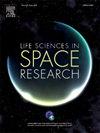抛物线飞行作为太空飞行的类比影响血管生成和脂质代谢
IF 2.8
3区 生物学
Q2 ASTRONOMY & ASTROPHYSICS
引用次数: 0
摘要
本研究旨在研究抛物线飞行诱导的失重和微重力对血管生成、脂质稳态和心血管疾病相关的特定生物标志物的影响,包括血管生成素(ANG)、血管生成素-1 (ANGPT-1)、血管生成素样蛋白4 (ANGPTL4)、热休克蛋白70 (HSP70)、转化生长因子-β (TGF-β)、血管内皮生长因子(VEGF)和血小板衍生生长因子亚基AA (PDGF-AA)。健康志愿者14名(平均年龄28.9岁;6名女性)参加了短期的失重和微重力抛物线飞行。在不同时间点(基线、抛物线飞行后1小时和24小时)采集静脉血,冷冻作为血清样本。最初,使用Proteome Profiler Angiogenesis Array筛选每个时间点的合并血清样本,以寻找血管生成相关蛋白的潜在改变。此外,使用酶联免疫吸附试验(ELISA)分析个体血液样本。蛋白质组阵列显示血管生成相关蛋白在抛物线飞行反应中总体减少。另一方面,与脂质稳态相关的蛋白质,如瘦素和TIMP-4,在抛物线飞行的反应中显著升高。对所选蛋白的单独分析显示,飞行后1小时ANGPTL4和HSP70水平略有升高,但无统计学意义(p = 0.7705)。然而,抛物线飞行后24 h,血清ANGPTL4浓度较前一个时间点显著降低(p = 0.0020)。同样,HSP70在飞行后1 h呈上升趋势(p = 0.8135),但在实验结束时显著下降(BL vs. 24 h: p = 0.0435;1 h vs. 24 h: p = 0.0031)。各组ANG、ANGPT1、TGF-β1、VEGF、PDGF-AA浓度在各时间点均无显著差异。本研究结果表明,暴露于重力变化,如失重和微重力,可能导致血管生成和脂质稳态的相关变化。在抛物线飞行的短期反应中,瘦素和TIMP-4以及ANGPTL4的上调可能导致脂质代谢紊乱,潜在地增加心血管或肝脏事件的可能性。需要进一步研究以更好地了解微重力和失重对血管生成和脂质代谢的影响,以保护宇航员在长期太空任务期间的健康。本文章由计算机程序翻译,如有差异,请以英文原文为准。
Parabolic flight as a space-flight analogon impacts angiogenesis and lipid metabolism
This study aimed to examine the effects of weightlessness and microgravity, induced by parabolic flight, on specific biomarkers associated with angiogenesis, lipid homeostasis, and cardiovascular diseases, including angiogenin (ANG), angiopoietin-1 (ANGPT-1), angiopoietin-like protein 4 (ANGPTL4), heat shock protein 70 (HSP70), transforming growth factor-beta (TGF-β), vascular endothelial growth factor (VEGF), and platelet-derived growth factor subunit AA (PDGF-AA).
14 healthy volunteers (mean age: 28.9 years; 6 females) participated in short-term sessions of weightlessness and microgravity using parabolic flights. Venous blood samples were collected at different time points (baseline, 1 h, and 24 h after parabolic flight) and frozen as serum samples. Initially, Proteome Profiler Angiogenesis Array was used to screen pooled serum samples of each time point for potential alterations of angiogenesis-associated proteins. Additionally, individual blood samples were analyzed using enzyme-linked immunosorbent assay (ELISA).
Proteome Arrays revealed an overall decrease of angiogenesis-associated proteins in response to parabolic flight. On the other hand, proteins associated with lipid homeostasis, such as Leptin and TIMP-4, were significantly elevated in response to parabolic flight. Individual analysis of selected proteins solely revealed a slight increase of ANGPTL4 and HSP70 levels 1 hour post-flight, although without statistical significance (p = 0.7705). Nevertheless, 24 h after parabolic flight, ANGPTL4 concentrations in serum significantly decreased compared to the preceding time point (p = 0.0020). Similarly, HSP70 was tendentially elevated 1 h after flight (p = 0.8135), though significantly declined at the end of the experiment (BL vs. 24 h: p = 0.0435; 1 h vs. 24 h: p = 0.0031). No significant differences could be observed in ANG, ANGPT1, TGF-β1, VEGF, and PDGF-AA concentrations at any time point.
The findings of this study suggest that exposure to gravitational changes, such as weightlessness and microgravity, may lead to relevant changes in angiogenesis and lipid homeostasis. The upregulation of Leptin and TIMP-4, as well as ANGPTL4 in short-term response to parabolic flight poses a risk to disturbances in lipid metabolism, potentially increasing the likelihood of cardiovascular or hepatic events. Further research is needed to better understand the impact of microgravity and weightlessness on angiogenesis and lipid metabolism to protect astronaut health during prolonged space missions.
求助全文
通过发布文献求助,成功后即可免费获取论文全文。
去求助
来源期刊

Life Sciences in Space Research
Agricultural and Biological Sciences-Agricultural and Biological Sciences (miscellaneous)
CiteScore
5.30
自引率
8.00%
发文量
69
期刊介绍:
Life Sciences in Space Research publishes high quality original research and review articles in areas previously covered by the Life Sciences section of COSPAR''s other society journal Advances in Space Research.
Life Sciences in Space Research features an editorial team of top scientists in the space radiation field and guarantees a fast turnaround time from submission to editorial decision.
 求助内容:
求助内容: 应助结果提醒方式:
应助结果提醒方式:


